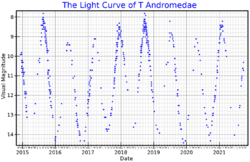Astronomy:T Andromedae
| Observation data Equinox J2000.0]] (ICRS) | |
|---|---|
| Constellation | Andromeda |
| Right ascension | 00h 22m 23.14956s[2] |
| Declination | +26° 59′ 45.73676″[2] |
| Apparent magnitude (V) | 7.70 – 14.30 variable [3] |
| Characteristics | |
| Spectral type | M4e-M7.5e[3] |
| B−V color index | 2.63[4] |
| Variable type | Mira[3] |
| Astrometry | |
| Radial velocity (Rv) | −90±10[4] km/s |
| Proper motion (μ) | RA: −7.108[2] mas/yr Dec.: −3.352[2] mas/yr |
| Parallax (π) | 0.5913 ± 0.0815[2] mas |
| Distance | approx. 5,500 ly (approx. 1,700 pc) |
| Details | |
| Mass | 4.9[5] M☉ |
| Luminosity | 8.928[6] L☉ |
| Surface gravity (log g) | −0.51[5] cgs |
| Temperature | 3,235[5] K |
| Metallicity [Fe/H] | −0.39[5] dex |
| Other designations | |
BD +26°43, HD 1795, SAO 73930 | |
| Database references | |
| SIMBAD | data |
T Andromedae (T And) is a variable star of the Mira type in the constellation Andromeda. Like all the stars of this kind, T And is a cool asymptotic giant branch star of spectral type M4e-M7.5e. Its brightness varies periodically, completing a cycle in 281 days. The peak luminosity, however, is different every variability cycle, but can reach a peak magnitude mv=7.70.[3]
Thomas David Anderson discovered that T Andromedae is a variable star, in 1894.[7] The next year, Edward Charles Pickering examined archival photographic plates to derive a light curve for the star, and calculated a period of 281 days.[8]
Measurements of the angular size variations of T And made with the Palomar Testbed Interferometer show no clear correlation with the star's brightness variations.[9][10]
References
- ↑ "Download Data". AAVSO. https://www.aavso.org/data-download.
- ↑ 2.0 2.1 2.2 2.3 2.4 Vallenari, A. et al. (2022). "Gaia Data Release 3. Summary of the content and survey properties". Astronomy & Astrophysics. doi:10.1051/0004-6361/202243940 Gaia DR3 record for this source at VizieR.
- ↑ 3.0 3.1 3.2 3.3 General Catalogue of Variable Stars, s.v. T. And.
- ↑ 4.0 4.1 "T And". SIMBAD. Centre de données astronomiques de Strasbourg. http://simbad.u-strasbg.fr/simbad/sim-basic?Ident=T+And.
- ↑ 5.0 5.1 5.2 5.3 Anders, F.; Khalatyan, A.; Queiroz, A. B. A.; Chiappini, C.; Ardevol, J.; Casamiquela, L.; Figueras, F.; Jimenez-Arranz, O. et al. (2022). "VizieR Online Data Catalog: StarHorse2, Gaia EDR3 photo-astrometric distances (Anders+, 2022)". Vizier Online Data Catalog. Bibcode: 2022yCat.1354....0A.
- ↑ Brown, A. G. A. (August 2018). "Gaia Data Release 2: Summary of the contents and survey properties". Astronomy & Astrophysics 616: A1. doi:10.1051/0004-6361/201833051. Bibcode: 2018A&A...616A...1G. Gaia DR2 record for this source at VizieR.
- ↑ Espin, T. E.; Anderson, T. D. (January 1894). "New variable stars". Astronomy and Astro-Physics 13: 63. https://archive.org/details/sim_astronomy-and-astro-physics_1894-01_13_2/page/62/mode/2up. Retrieved 23 February 2023.
- ↑ Pickering, E. C. (April 1895). "T Andromedae". Astrophysical Journal 1: 305–308. doi:10.1086/140056. Bibcode: 1895ApJ.....1..305P. https://ui.adsabs.harvard.edu/abs/1895ApJ.....1..305P. Retrieved 23 February 2023.
- ↑ Creech-Eakman, M. J.; Thompson, R. R. (2009). "The Biggest, Baddest, Coolest Stars ASP Conference Series, Vol. 412". The Biggest (Astronomical Society of the Pacific) 412: 149. Bibcode: 2009ASPC..412..149C.
- ↑ Thompson, R. R.; Creech-Eakman, M. J. (2004). American Astronomical Society Meeting Abstracts. 205. American Astronomical Society. Bibcode: 2004AAS...205.1205T.
External links
 |


